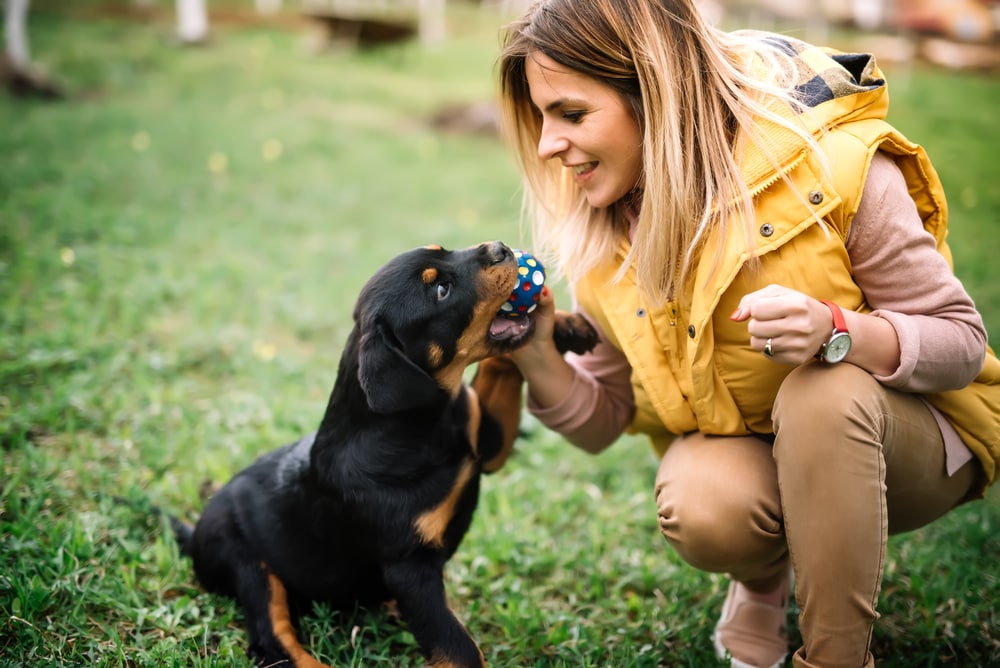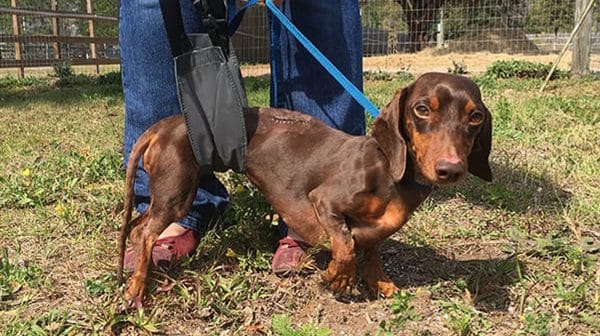It’s easy to understand the appeal of a Rottweiler. It’s a big, strong, smart dog that’s capable of performing well in a number of areas — obedience, herding and therapy work — an all-around good friend and home guardian. That said, the Rottweiler isn’t a dog for everyone for those very same reasons: It’s a big, strong, smart dog that needs — not wants — a job to do. When its energy and intelligence aren’t channeled into constructive work, such as competition, herding or doing chores around the home, a Rottweiler can become a destructive bully rather than the companion and guardian it’s meant to be.
The Rottweiler breed standard (a written description of how the ideal dog looks and acts) calls for a dog that’s calm, confident and courageous, that responds quietly and with a wait-and-see attitude to influences in its environment. But to attain those characteristics, a Rottie needs firm and fair guidance from people, starting with the breeder and continuing throughout its life. That means starting the first day you bring your new puppy home.
“Puppies are extremely easy to train; they’re sponges,” says Paula Cingota of Jamul, California, who’s been breeding and training Rottweilers for 44 years. “They’ll absorb anything you ask.” By the time Cingota’s puppies are 7 or 8 weeks old, they know the commands sit, down and stay. By the time they’re 16 weeks old, they can do a half-hour down or a 10-minute sit in the house. With young puppies, Cingota uses positive motivation, such as dog training treats and toys, and uses her hands—a finger in the flat collar or a hand beneath the body—to guide puppies and show them where they need to be.
Her secret? Consistency. “Everything must be black and white—no gray areas,” Cingota says. “If you leave a gray area, a puppy will manipulate you. The second that gray area is there, they’re going to think, ‘Oh, so I don’t have to sit every time I come in the door. Okay, I’m going to test you every time I come in the door now. I’ll just try and walk right in.’ But if you’re consistent, you’re going to have a fabulously trained dog.”
Earning a Rottie’s Respect
Consistency in training is important with all dogs, but with the Rottweiler it’s a must. This is a kind and loving dog, sure, but it’s also willful. “Some people say Rottweilers are stubborn, but I don’t,” Cingota says. What’s the difference between stubborn and willful? A stubborn dog is one whose attitude is: “You can’t make me do that,” Cingota says. A willful dog’s attitude is: “Show me why I need to do this.” For that reason, the Rottweiler needs an owner who has real leadership qualities, such as firmness and fairness, who can earn the dog’s respect.
Earning a Rottweiler’s respect involves setting boundaries and teaching consequences, says Laura Noll of Jamul, California, who’s trained and earned titles on many Rottweilers. From day one, you need to show your Rottweiler that you’re in charge. That never means hitting the dog, but it does mean providing structure as well as consequences for inappropriate behavior. You must also understand consequences, Noll says.
“When you raise a child and he never learns consequences, he never learns right from wrong, and that child ends up being a bully, a hoodlum or a spoiled brat,” Noll explains. “The same is true for a dog. If you don’t give it structure and consequences for bad behavior, you’re going to end up with a thug. Rottweilers in this society cannot afford to become thugs, because that’s how we get breed-specific legislation and your Rottweiler becomes banned from your community.”
Consistent, Constructive and Fair
Decide from the beginning what you want to teach your Rottweiler. If it’s not okay for it to get into the trash, run through the screen door or jump up on people, then correct it every time it does those things. Your Rottweiler will notice if you let things slide. “They’ll try to get away with everything they can, but once they learn you’re not going to give up, they’ll soon give in,” says Ginger Miller of Gerber, California, vice president of the Delta Rottweiler Owners Club.
Beyond that, it’s even more important to teach your Rottweiler alternatives to these behaviors. Teach the leave it command. Teach your dog to sit when it meets people. Teach it to sit and wait at doors or gates while you go through first. Cingota allows her dogs on the bed, but not other furniture, and she’s taught them that she gets in first and they can have what space is left.
“If I walk into my bedroom and say, ‘Okay dogs, mom’s going to bed,’ everybody gets off the bed,” Cintoga says. “I get in, and whatever room is left is fair game. They’re not allowed on my furniture and they don’t get on the furniture. They’re taught leave it immediately as puppies. I could leave a steak dinner on a coffee table and not have a dog touch it because I’m consistent. Plus, they’re super intelligent.”
That super intelligence must be channeled into constructive activity. If you leave your Rottweiler to vegetate in the backyard, it’ll devise its own occupation, and it’ll probably involve the destruction of your yard. And that’s a minor problem compared to the worst-case scenario: that your Rottweiler will develop into an aggressive dog with no discrimination.
Choose Carefully
Rottweilers have a range of energy levels, from couch potato to whirling dervish. A high level of drive (the desire to work) often comes as an unpleasant surprise to new owners, or to people whose first Rottweiler had more of a laid-back personality.
It’s essential to choose a puppy from a breeder who can help you discern which puppy has the personality and energy level appropriate for your family and lifestyle. “If you pick a really high-drive puppy because it’s cute and animated in the litter, and you bring this busy dog home to the city, it’s going to dismantle your living room,” Noll says.
For a family companion, Miller recommends choosing the puppy that sits back, watches and waits for attention, rather than the puppy that rushes to the head of the pack as if to say, “Here I am, here I am.” A more dominant dog will make a super show, obedience or herding dog, but it’s probably not suited for a family with a relaxed lifestyle.
The good news? Every Rottweiler, no matter how driven, has an off switch. “Once we’re done herding sheep and we’re back in the house,” Noll says, “they just lounge around.”
Posted By: Chewy Editorial
Featured Image: Via bogdanhoda/Shutterstock
Share:









